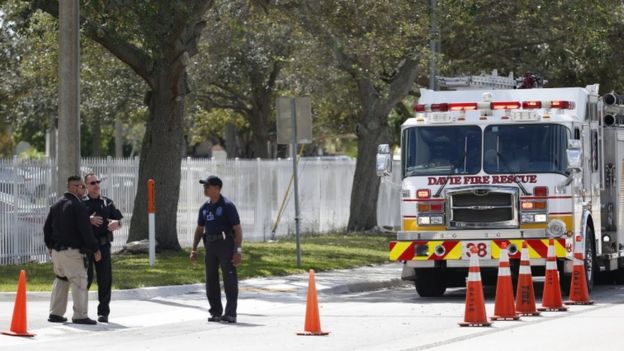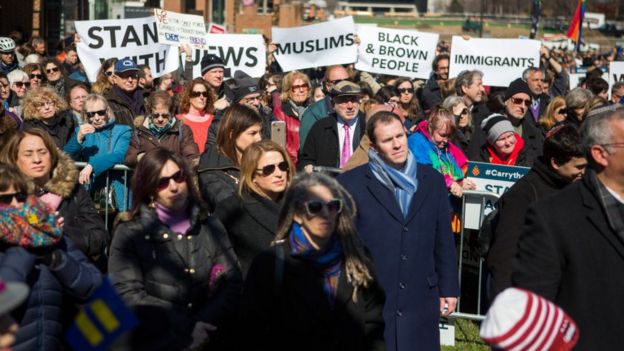In the short and censored clip, the man says: "My name is Kim Han-sol, from North Korea, part of the Kim family."
He says he is with his mother and sister, but there are no details on the date or location. It's the Kim family's first public comment since the murder.
Kim Jong-nam died after attackers smeared nerve agent on his face in Kuala Lumpur airport, Malaysia.
Relations between North Korea and Malaysia have been severely strained since the 13 February murder, with North Korea barring Malaysians from leaving its territory and Malaysia responding in kind.
However, Malaysian Prime Minister Najib Razak on Wednesday appeared to have struck a softer tone with Pyongyang, saying his country still wanted to negotiate on the issue.
He also said there were no plans to cut diplomatic relations.
What is in the video?
The 40-second clip features the man identified as Kim Han-sol sitting against a grey wall. In perfect, slightly accented English, he introduces himself and says: "My father has been killed a few days ago. I'm currently with my mother and my sister."
He shows what appears to be a North Korean diplomatic passport to confirm his identity, though the details have been blocked out, and says he is "grateful to..." before the audio and image are censored.
He ends by saying: "We hope this gets better soon."
As his father was killed on 13 February, it is unclear when and where the video was filmed, and what Kim Han-sol's current whereabouts are.
Officials at South Korea's Unification Ministry and National Intelligence Service say the man in the video is Kim Han-sol.
Who posted the video?
It was put online by a group called the Cheollima Civil Defense - they have not previously been heard of, and appear to have registered a website and YouTube account only recently.
South Korea's Yonhap news agency said the group presumably assists escaping North Koreans - there is a town south-west of Pyongyang named Cheollima. They sent the video link to the Malaysia correspondent for Channel News Asia.
A message in English on the CCD website said it had responded to a request for protection from "survivors of the family of Kim Jong-nam".
"We have in the past addressed other urgent needs for protection. This will be the first and last statement on this particular matter, and the present whereabouts of this family will not be addressed."
It also thanked several countries for offering emergency humanitarian assistance, including the Netherlands, China and the US and "a fourth government to remain unnamed", while giving particular thanks to the Netherlands ambassador in South Korea, AJA Embrechts.
- Kim Han-sol: The open-minded son of Kim Jong-nam
- Who in North Korea could organise a VX murder?
- Main players in mysterious killing
Who is Kim Han-sol?
He is believed to be 21, and has lived a low-profile life since his father's exile, growing up in Macau and China.
In 2012, he appeared in a TV interview for Finnish TV from Bosnia, where he was studying, saying he had never met his powerful uncle or his grandfather, the late Kim Jong-il.
He said he had "always dreamed that one day I would go back and make things better and make it easier for the people" of North Korea.
Where has the murder investigation got to?
Kim Jong-nam was once seen as a potential future leader of North Korea, but was bypassed for succession in favour of his younger half-brother. He has since lived in exile.
Though it fiercely denies this, North Korea is widely assumed to have carried out the attack with the deadly toxin, potentially to remove a threat to the leadership.
Mr Kim's body remains in a mortuary in Kuala Lumpur. Malaysia has said it will not release it until the Kim family provides DNA samples.
Two women have been charged with murder - one Indonesian, one Vietnamese - but both say they were duped into killing Kim, and believed they were taking part in a televised prank.
Malaysia is seeking seven North Koreans, including a diplomat - it believes three suspects are hiding in the North's embassy in Kuala Lumpur, which has been surrounded by police.
North Korea has yet to confirm that the dead man is Mr Kim - he was travelling under a passport in a different name.
It says the man died of a heart attack, not a chemical attack, and is furious that a post-mortem was carried out. It has accused Malaysia of conducting a biased investigation and colluding with its enemies, and is demanding to be given the body.
Tit-for-tat exit bans
In an extraordinary move on Tuesday, North Korea banned Malaysians in the country from leaving, citing security reasons.
Malaysia called this an "abhorrent act" which was "in total disregard of all international law and diplomatic norms", then did the same thing for North Koreans in Malaysia.
Both countries have already expelled each other's ambassadors.
In Malaysia's state of Sarawak, immigration officials have detained dozens of North Koreans with expired work permits.
So far, 140 North Koreans working in the private construction sector are being held by the authorities, who say they are awaiting further instructions from the government.
Meanwhile, North Korea is refusing to allow approximately 11 Malaysian nationals to leave the country.





